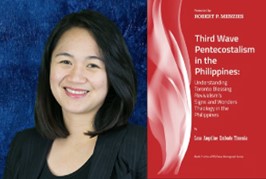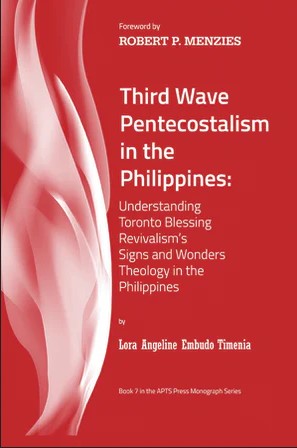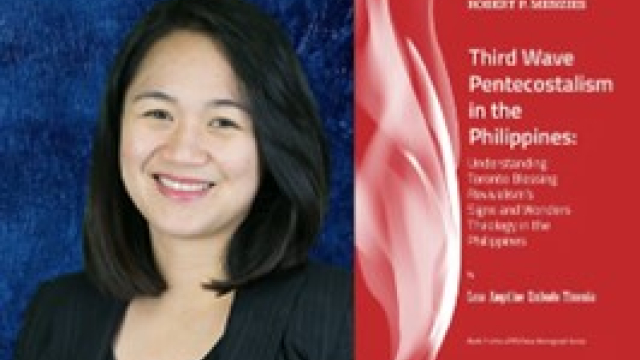Click to join the conversation with over 500,000 Pentecostal believers and scholars
Click to get our FREE MOBILE APP and stay connected
| PentecostalTheology.com



The Pneuma Review speaks with Lora Timenia, an Asian Pentecostal scholar, about her book, Third Wave of Pentecostalism in the Philippines: Understanding Toronto Blessing Revivalism’s Signs and Wonders Theology in the Philippines, and what she learned about the Toronto Blessing as a classical Pentecostal.

PneumaReview.com: Please tell our readers a little bit about your spiritual background.
Lora Timenia: I was born into a Roman Catholic family, though our clan was more folk in our religiosity. I converted to Protestant Christianity in 2002, and then joined an Assemblies of God church in my hometown. I submitted to water baptism in 2003 and received Spirit baptism with the manifestation of tongues-speech in 2008. I would describe my spirituality as that of a Filipino Pentecostal. I believe in the continued work of God in the world through Jesus and the Holy Spirit.
PneumaReview.com: How did you become interested in studying Toronto Blessing Theology and Practice?
Lora Timenia: I grew up in a Classical Pentecostal church. At the heart of our spirituality is the continuation of the prophetic ministry of the church. This prophetic spirituality manifested in charismatic worship, tongues-speech, interpretation of tongues, healing miracles, and deliverance ministries. So, my understanding of signs and wonders was within the framework of Spirit empowerment for end-time witness. Since my spiritual worldview was limited to this tradition, I was surprised when a group of Christians espoused what I considered as “unusual” manifestations of signs and wonders. I remembered joining a seminar where the preacher was training the participants to experience group visions and romanticized experiences with Jesus. He taught that signs and wonders included orbs, gold dust, blue fire, red fire, angel feathers and the like. I was confused. My classical Pentecostal tradition never taught me about these “signs.” Moreover, as I comb through the Bible, these “signs” weren’t mentioned. I began a journey of trying to understand where these teachings came from. It was later in my study that I traced the formal origins of the spirituality to the Toronto Blessing revival. Although antecedents of this spirituality came from the global Pentecostal/Charismatic movement, it was the Toronto Blessing of 1994 that brought this particular brand of spirituality together and later spread the “fire” to different parts of the world. Today, the church where the TB phenomena first occurred is called Catch the Fire.
PneumaReview.com: What are some of the different sources you consulted as you gathered information for your research?
Lora Timenia: First off, I had to study the global Pentecostal/Charismatic movement. It’s history, theologies, spirituality and various expressions in the world. I had to particularly understand its history and varied streams in the Philippines. To this end, I am indebted to APTS Press for their publication on Pentecostalism in the Philippines, as well as for their seminal work with Allan Anderson and Edmond Tang, entitled, Asian and Pentecostal. I also consulted Wonsuk Ma’s contribution on the Philippines in the New International Dictionary of Pentecostal/Charismatic Movements. Secondly, I read about the development of what Vinson Synan called the Third Wave Movement. With John Wimber, this group was also known as the Signs and Wonders Movement. Bill Jackson’s The Quest for the Radical Middle gave me a clear understanding and appreciation of Wimber’s movement. Thirdly, I had to read all the books that discussed the origins, transmutation and global spread of the Toronto Blessing. David Hilborn’s work, “Toronto” in Perspective, was exemplary and particularly helpful. I also read all the works that discussed this phenomenon. I especially appreciated the works of Margaret Poloma, Mark Cartledge, Stephen Hunt, David Pawson, and Gary McGee. Finally, I consulted all the works written by Filipino Third Wavers like Hiram Pangilinan and Apollo “Paul” Yadao. Through their writings, I could understand their theology and spirituality.
PneumaReview.com: Please mention some of the beliefs or practices that the Toronto Blessing Movement shares in common with classical Pentecostalism?
The Pentecostal/charismatic movement is diverse and we are all outflows of the worldwide renewing work of the Holy Spirit.
Lora Timenia: Essentially, classical Pentecostalism and those connected to the Toronto Blessing, are part of the global Pentecostal/Charismatic movement. Though our movement is diverse, in that there are many movements within the movement, we are all outflows of the worldwide renewing work of the Holy Spirit. We also share a particular view of divine encounter, that is God can be encountered in the here and now through Jesus and the Holy Spirit.
PneumaReview.com: What are some of the things that are different from classical Pentecostalism?
Lora Timenia: Classical Pentecostalism has a distinct theology of Spirit Baptism. We believe that Spirit baptism is distinct from and subsequent to conversion, and that it is an empowerment for eschatological witness. Charismatic manifestations, signs and wonders, and other forms of miraculous intervention are secondary to the proclamation of the Gospel. Basically, our view of the manifestation of signs and wonders is within the framework of evangelism and mission. We preach the gospel believing that signs will follow. In contrast, majority of those in connected to the Toronto Blessing revivalism affirm that supernatural manifestations are epi-phenomena of the kingdom of God and should be expected and sought after in the here and now. This is why it is unsurprising for some of their leaders to encourage their members to purposely seek the manifestation of signs and wonders or to train in signs and wonders ministry. For them, the purpose of supernatural manifestations is for divine reification (manifestation of the divine) and revivalism.
PneumaReview.com: The specific focus of your study concerns the Toronto Blessing Movement in the Philippines. Is there something about Filipino culture that might make this movement particularly attractive to Filipinos?
Lora Timenia: Yes, Filipino religious consciousness has affinity for religions of spirit and power. Our spiritual worldview inherently affirms supernatural manifestation and divine intervention.
PneumaReview.com: Would you say that spiritual manifestations are a significant part of Toronto Blessing Spirituality?
Lora Timenia: Yes, because they have a revivalist spirituality. Their definition of revival is the expansion of God’s kingdom through his “manifest presence.” This “manifest presence” is explained as miracles and supernatural living put on display. Hence, their spirituality leads them to expect spiritual manifestations as reifications of God’s love and power; also, these manifestations mystically connect them to divine reality and provides them with catharsis (e.g. spiritual healing) and a perceived intimate connection with God.

Lora Angeline Embudo Timenia, Third Wave Pentecostalism in the Philippines: Understanding Toronto Blessing Revivalism’s Signs and Wonders Theology in the Philippines (Baguio City, Philippines: Asia Pacific Theological Seminary Press, 2020), 192 pages, ISBN 9789718942918.
PneumaReview.com: In your book, Third Wave Pentecostalism in the Philippines, you present some criteria for evaluating spiritual manifestations. Please tell us briefly what they are.
Lora Timenia: I offered four open-ended questions:
- Does the manifestation have biblical precedent?
- Can the manifestation be used to point to the salvific purposes of God?
- Does the manifestation glorify God, and not humans or other beings?
- Does the manifestation conform to Scriptural teachings?
These questions stem from the assumption that manifestations of signs and wonders ought to have biblical precedent, be evangelistic (leads people into the faith), God-centered (not anthropocentric) and not in contradiction with essential biblical teachings.
PneumaReview.com: What can church leaders learn from the Third Wave and the Toronto Blessing?
Lora Timenia: The Third Wave movement and its phenomenon, the Toronto Blessing, is a revivification of mystical Christian spirituality. Their stream has somewhat revived mystic encounters with God through Jesus and the Holy Spirit. They also offer us a form of spirituality that provides cathartic experiences. Their emphasis on the manifest presence of God, bring into the fore the immanence of God. At the verification level of our theologizing, these manifest experiences contribute to a sense of illumination of and relational unity with God and other believers. To a certain extent, their spirituality is a good complement to varied Christian traditions worldwide.
PR
Learn more
Read John Lathrop’s review of Lora Timenia, Third Wave Pentecostalism in the Philippines.
Read Mike Dies’ review of John Arnott, “Living in Revival,” Spread the Fire (2001).
Read articles by Heidi Baker and Randy Clark, two scholars and leaders with connections to the early Toronto Blessing movement.
Read Malcolm Brubaker’s review of Bill Jackson, The Quest for the Radical Middle.
 Visit APTS Press for a free sample from Third Wave of Pentecostalism in the Philippines and more books by Asian Pentecostal scholars.
Visit APTS Press for a free sample from Third Wave of Pentecostalism in the Philippines and more books by Asian Pentecostal scholars.
APTS Press and Asian Journal of Pentecostal Studies Interview with Lora Timenia about her book (Length: 22:31).
PneumaReview.com author Dave Johnson speaks with Lora Timenia about her book Third Wave of Pentecostalism in the Philippines: Understanding Toronto Blessing Revivalism’s Signs and Wonders Theology in the Philippines



Anonymous
well WHAT have we learned Peter Vandever John Mushenhouse Duane L Burgess God poured out in renewal in 1994 in Canada. What did we learned from the Toronto Blessing? What is your story? https://www.pentecostaltheology.com/the-toronto-blessing-what-did-we-learn/
Anonymous
To avoid anything from those heretics.
Anonymous
John Mushenhouse Calling Toronto teaching ‘Charismatic theology’ is problematic?
Anonymous
Even speaking of it outside of a stern warning about it is problematic.
Anonymous
John Mushenhouse SURE unlike the non-theology of John Digsby
Anonymous
If you think as Charismatic being the second wave in 50-70s who came from mainline denominations – maybe, but if you go back to Wagner is very much Charismatic
As already mentioned to Gary Micheal New Apostolic Reformation originates directly from C. Peter Wagner (1930-2016) who took the idea from G12 while in South America and coined the term in 1994 after trying several alternatives such as “Neopentecostal,” “Neocharismatic,” “Independent,” “Post denominational” or “Nondenominational.” and Third-wave” (also a term coined by Wagner)
There are several factors here
1. After stating 1 thing in his Secular City, in Fire from Heaven Harvey Cox expounded on South America exploding for the Gospel while North American churches – in the city – slowly dying
2. Wagner @ Fuller and AG were all seeking an answer for church growth and they found it in
1) charismatic renewal in N America
2) S American revivalism in the 1980s – I think particularly Brazil, though Wagner was in a different area but borrowed a lot from G12 and also Cox, who as a thinker nailed the Pentecostal growth idea
3rd wave IMO was not only Wagner’s term. It was used naturally after the Charismatics and Yes it was more Charismatic theology as most of South American Pentecostals came running straight from the Catholic churches “Independent” and “Post denominational” were also not his terms but he tried them well. “Neopentecostal” and “Neocharismatic” he used both almost interchangeably But the term that stuck was NAR Wagner subsequently wrote of NAR in his books:
The New Apostolic Churches (1998);
Churchquake! (1999);
Apostles and Prophets (2000);
Changing Church (2004);
and Apostles Today (2006).
Now back to Toronto airport revival – there is IMO no other place in hte 90s where NAR was more prominent. Terry Wiles may correct me of course but Toronto had every facet of NAR present within them. This IMO characterizes their theology strictly Charismatic all the way to the time when Wagner (and others) made the curve to post-Trib and in some cases even to post-Mil also borrowed from the very Catholic theology of Augustine spread in S America and in some point even into the Liberation Gospel and Rushdoony’s Christian reconstructionism
Anonymous
John Digsby perhaps Michael Chauncey Peter Vandever Brett Dobbs can tell us more since you obviously cannot
Anonymous
all ya need from me is get the catholic out. in the case of fallen angels thats all catholic.
you read a bible only about angels and ya dont get what RC has rooted in your cathoprot religion.
ya pray about it, make contact and ya get a much more benevolent and anticatholic fear belief system, grounded in love.
Anonymous
Narcissists, even the pathological kind, can be found in church leadership. They are cunning in how they convince people they are champions of truth & fighters for righteousness, but in actuality, they are self-serving and greedy for power.
Anonymous
Troy Day I heard mixed reviews on Toronto, some people were positively affected and draw to Christ others criticized barking and weird manifestations without biblical precedent. I did not go. I met Georgian Banov at my home church. I appreciated his missionary zeal and obvious love for Jesus. It’s not unusual for there to be both criticism and approval in any religious movement. Maybe God is in it but man is also in it.
Anonymous
Narcissists, even the pathological kind, can be found in church leadership. They are cunning in how they convince people they are champions of truth & fighters for righteousness, but in actuality, they are self-serving and greedy for power.
Anonymous
The Toronto Blessing is another false spiritual event, lacking sound biblical support.
Anonymous
why?